The PNY CS1311 and CS2211 SSD Review: MLC vs TLC at 15nm
by Billy Tallis on April 15, 2016 8:00 AM ESTAnandTech Storage Bench - The Destroyer
The Destroyer is an extremely long test replicating the access patterns of very IO-intensive desktop usage. A detailed breakdown can be found in this article. Like real-world usage and unlike our Iometer tests, the drives do get the occasional break that allows for some background garbage collection and flushing caches, but those idle times are limited to 25ms so that it doesn't take all week to run the test.
We quantify performance on this test by reporting the drive's average data throughput, a few data points about its latency, and the total energy used by the drive over the course of the test.
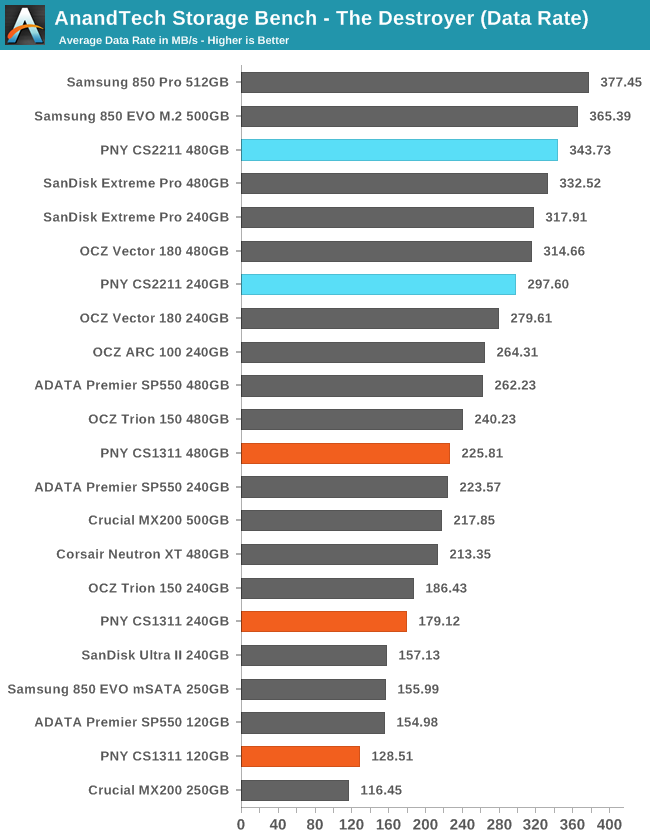
The PNY CS2211's average data rate on The Destroyer can't quite match what Samsung's 850 Pro and EVO deliver, but it trades blows with SanDisk's Extreme Pro and is a huge improvement over the Corsair Neutron XT. The CS1311 falls behind both the OCZ Trion 150 and the ADATA SP550.
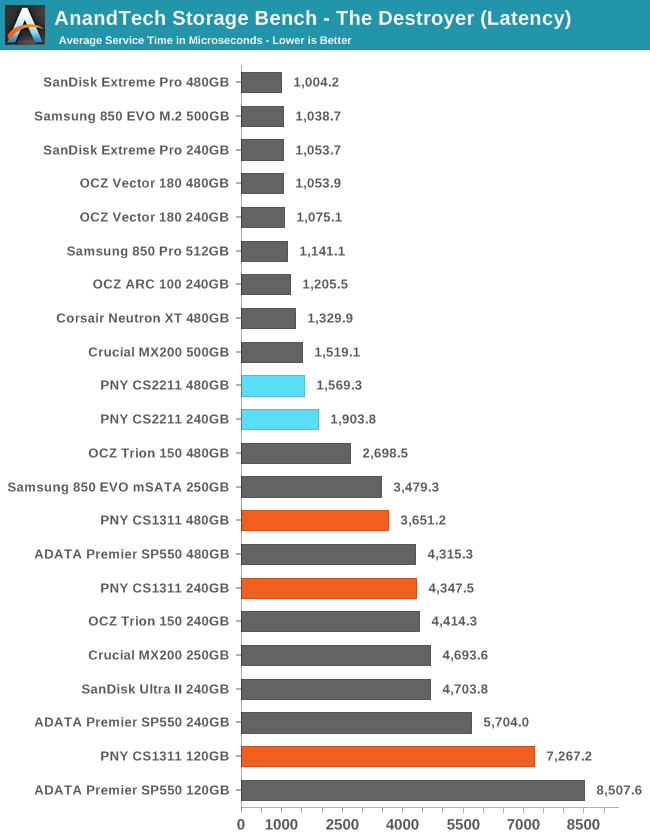
The average service time of the CS2211 is at the bottom of the normal range for most MLC drives. The CS1311 has a clear advantage over the SP550 and also manages to tie the Trion 150 at 240GB, but still shows twice the latency of the CS2211.
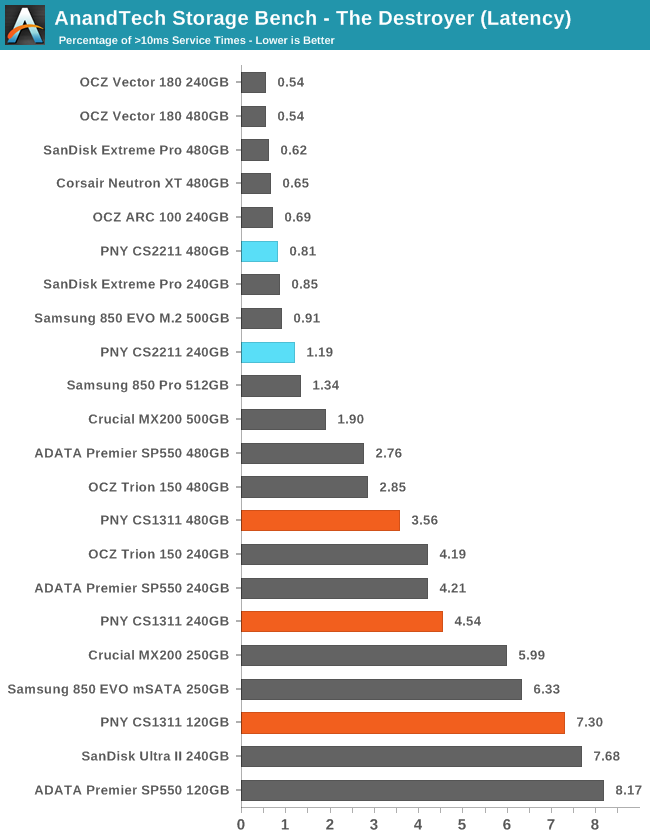
The latency outliers above the 10ms threshold are unremarkable for the CS2211. The CS1311 falls significantly significantly behind the SP550 and Trion 150 except at 120GB where the CS1311 beats the SP550 (but both 120GB drives are pretty much overwhelmed by The Destroyer).
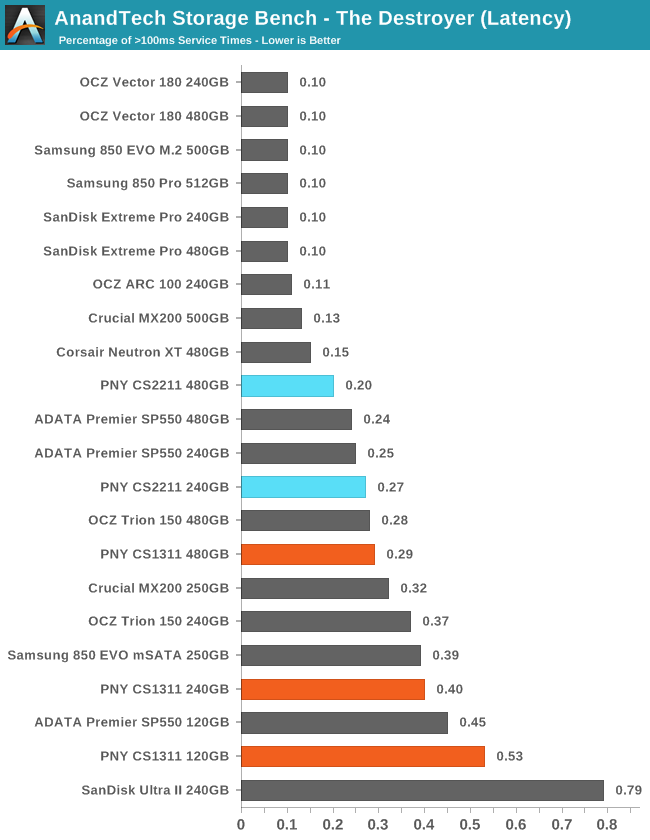
With a 100ms threshold for latency outliers, the total spread of scores is a bit smaller and the CS2211 is no longer in the top tier. The 240GB CS2211 is even a little bit slower than the 240GB SP550, which shows that using MLC flash isn't all there is to delivering good performance.
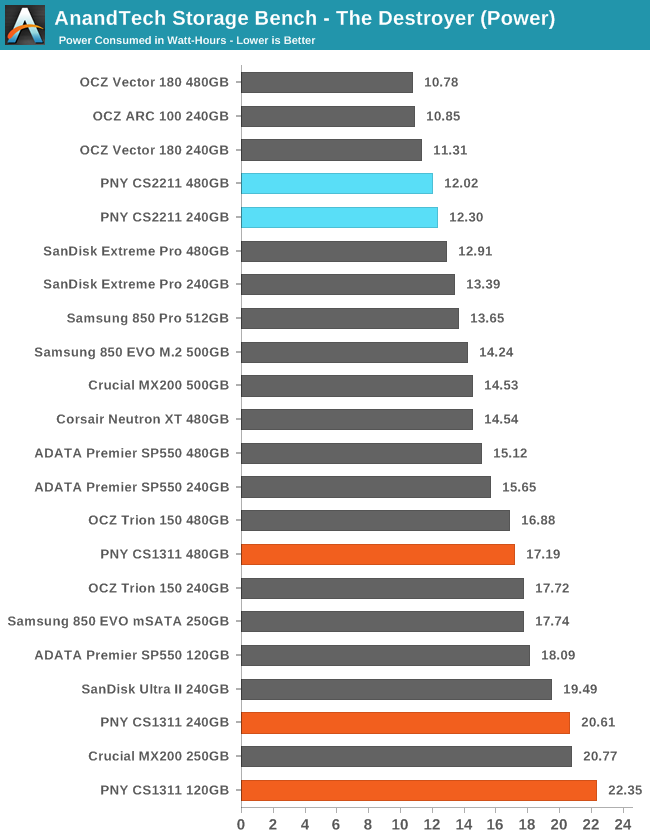
Power usage of the CS2211 is pretty good, as only drives based on Silicon Motion's SM2246EN controller or OCZ's Barefoot 3 controller use less energy over the course of the test. The low performance of the CS1311 puts it at or near the bottom for each capacity.










43 Comments
View All Comments
DanoSpumoni - Saturday, April 16, 2016 - link
When 2TB SSDs drop below $200 then i'll bite... from the current trend it looks like thats only a couple years away maybe lesszodiacfml - Friday, April 15, 2016 - link
It has been like that ever since they unleashed V-NAND drives. Despite being on top, I think they are selling them competitively to remove or not allow smaller players to enter.zepi - Friday, April 15, 2016 - link
At least in Europe Samsung has priced itself out of the game completely. I've yet to see EVO ever even near the top of the GB per euro/£ list when I've been searching for drives. Usually Crucial seems to take to top stop and I've yet to see a reason buy anything else.Like now as I write I see 480GB BX200 being available for 97€ taxes included in amazon.de, cheapest 500GB EVO is 141€, so straight away +45% or something like that. I've yet to see it ever being even remotely competitive with sandisks or corsairs in Europe.
It still seems to sell well though being often in the top lists of many retailers.
DeepLake - Friday, April 15, 2016 - link
Last i checked US prices for Samsung EVO were also very high. I dont know what other commenters are talking about. Are they ignorant or Samsung agents?BrokenCrayons - Friday, April 15, 2016 - link
Thanks for the review. It's good to see SSD prices falling thanks to TLC and a standardized, inexpensive controller. I've been happy with the added capacity at a lower price point thanks to TLC flash. TLC performance behind budget controllers seems good enough now to make MLC SSDs a poor choice in a lot of desktop and laptop usage scenarios.haukionkannel - Friday, April 15, 2016 - link
So true. They Are slover, but the prises are good.hansmuff - Friday, April 15, 2016 - link
They make excellent game drives. With games coming in at 50GB at times, a 480 or 960GB TLC drive with so-so speeds is perfectly acceptable.bug77 - Friday, April 15, 2016 - link
I would love to see the SSD price fall fir any reason but planar TLC :(The performance of planar TLC is not that big of an issue, but the reduced lifetime is.
LostWander - Friday, April 15, 2016 - link
Is the reduced lifetime really that extreme? As far as I've seen it's still far better than anything you would get out of a conventional HDD. Adding in better general performance and it seems like less intensive applications (like a game or media storage drive) would still be perfectly acceptable for TLCbug77 - Friday, April 15, 2016 - link
You get 3 years warranty at most (two years less than MLC/V-NAND TLC) and something like 1000 p/e cycles. Good enough for many things (music, videos), but not if you're writing a lot (e.g. a system drive or a game drive).And while TLC itself is not so bad (it's hardly worth it imho, because it's not much cheaper), if the trend continues we'll have some pretty crappy drives in our hands soon.